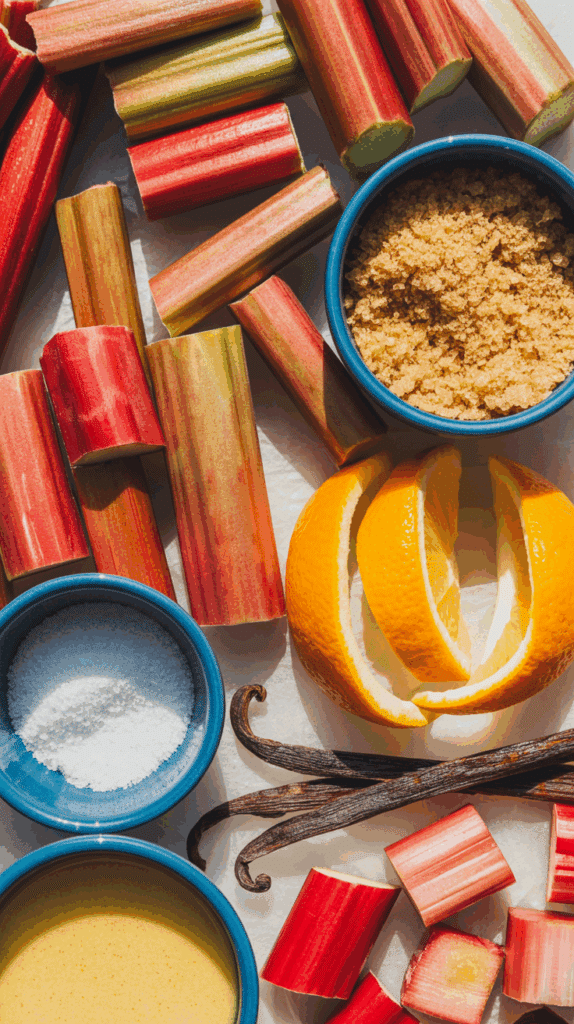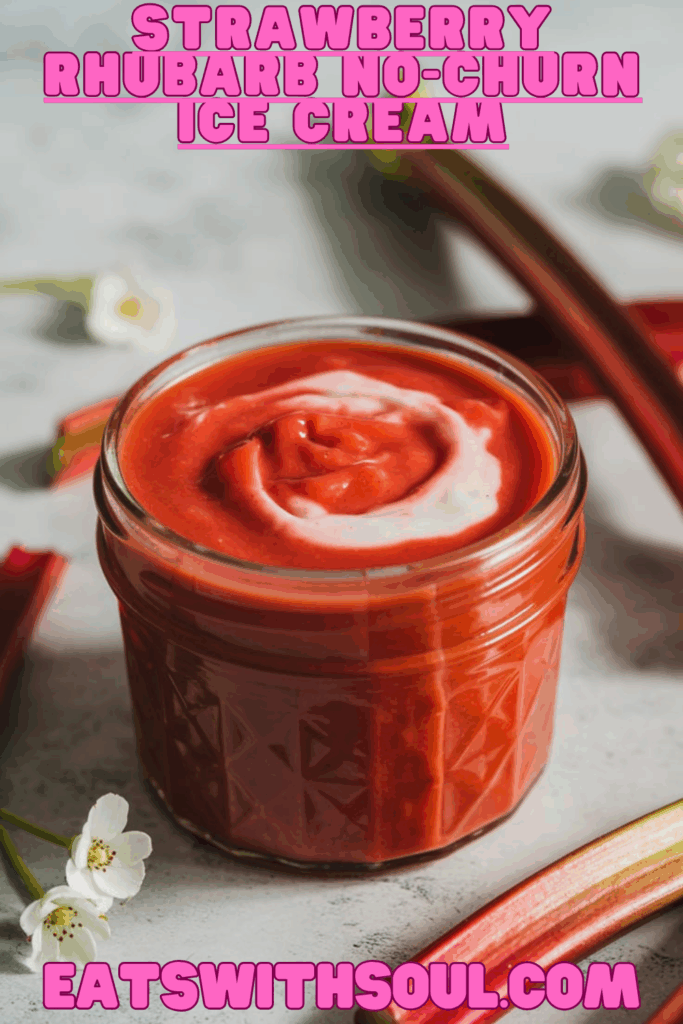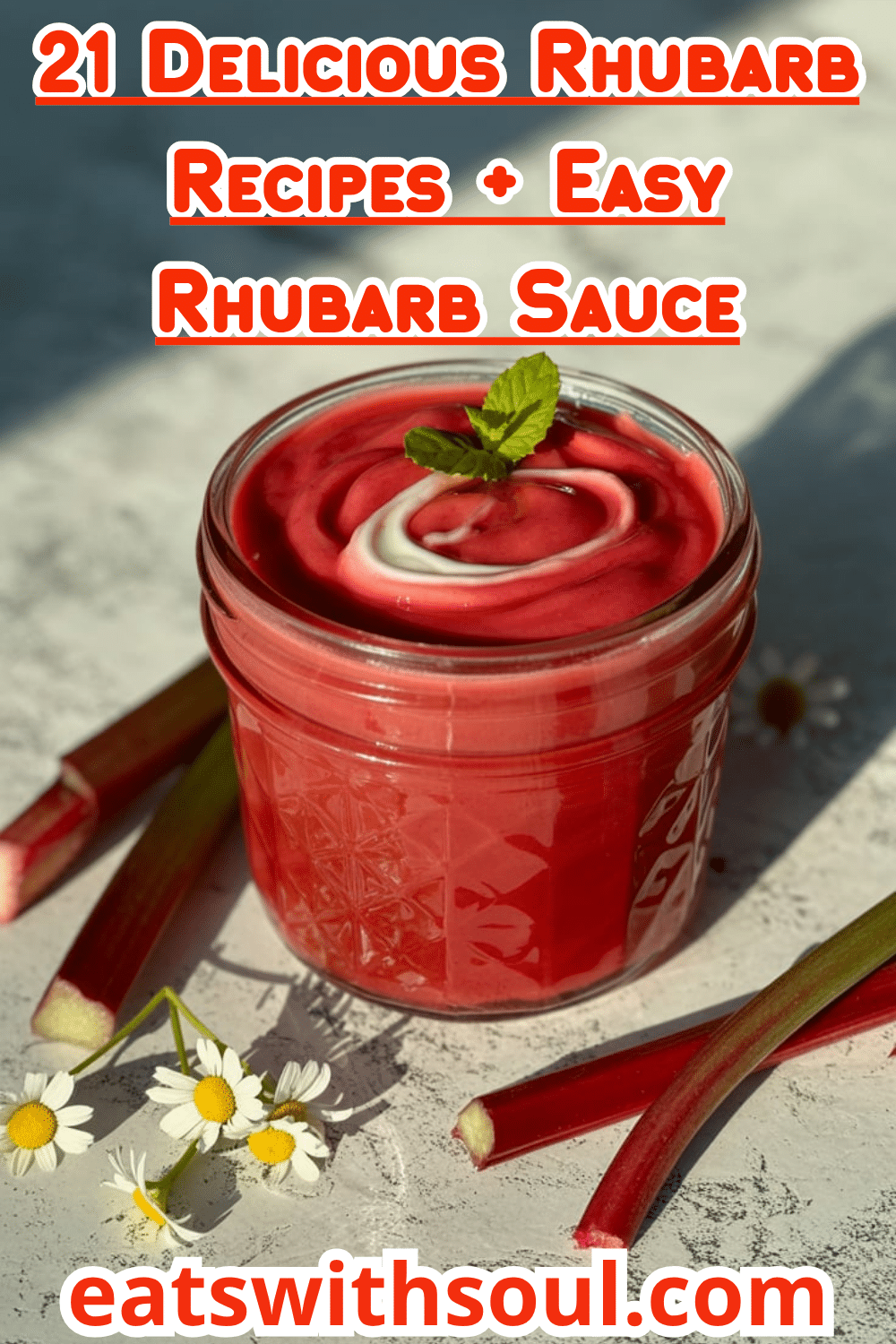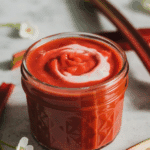Introduction & Inspiration
There is a pure, simple joy in transforming the tart, ruby-red stalks of fresh rhubarb into a luscious, beautifully balanced sauce, and this recipe shows you how with incredible ease! This “4-Ingredient” Fresh Rhubarb Sauce (with salt and vanilla as essential flavor enhancers) is a celebration of seasonal simplicity. It involves gently macerating fresh rhubarb with sugar, infusing it with strips of fresh orange peel as it simmers, then blending it all until silky smooth and finishing with rich vanilla bean paste. It is a perfect base for so many desserts and breakfast treats!
My inspiration for this recipe comes from wanting a truly pure rhubarb sauce that lets the fruit’s unique character shine, enhanced only by simple, classic pairings. The orange peel provides a wonderful aromatic brightness, while the vanilla bean paste adds a luxurious, floral depth. This versatile sauce is just one of many delicious rhubarb recipes you can create, but it’s a foundational one you’ll return to again and again.
This sauce is fantastic for spooning over ice cream, swirling into yogurt, topping pound cake, or accompanying a cheese plate. It’s a delightful way to capture the essence of spring and early summer in a jar! It is a perfect easy sauce recipe.
Nostalgic Appeal / Comfort Factor
Homemade fruit sauces and compotes hold a special nostalgic charm, often reminiscent of seasonal preserving, grandma’s kitchen, or the simple comfort of spooning a sweet, fruity topping over a warm dessert. Rhubarb itself is a nostalgic flavor for many, a classic harbinger of spring in gardens across the country, used in beloved pies, crumbles, and sauces that signal the start of warmer seasons.
This recipe taps directly into that comforting nostalgia. The process of gently simmering the fruit and sugar fills the kitchen with a sweet, inviting aroma that is both heartwarming and delicious. The final result is a simple, honest, and incredibly delicious sauce that tastes like pure, home-cooked goodness, perfect for bringing a touch of comfort to any dish it accompanies.
Making this sauce is a simple ritual that yields a comforting and delightful result, perfect for enjoying and sharing. A perfect comfort food sauce.
Homemade Focus
This recipe is a wonderful example of creating something truly delicious from scratch using just a few fresh ingredients and straightforward techniques. You’re starting with fresh rhubarb, preparing it yourself, and then using the classic technique of maceration – allowing the fruit to sit with sugar to draw out its natural juices, which creates a better-textured and more flavorful final sauce.
The homemade focus shines in the gentle simmering process that softens the rhubarb and infuses it with the beautiful aroma of the fresh orange peel. Blending the cooked sauce until silky smooth and then finishing it with high-quality vanilla bean paste are the final homemade touches that create its luscious consistency and rich, complex flavor.
It’s about taking simple, seasonal fruit and transforming it through thoughtful, from-scratch preparation into a vibrant and versatile sauce that tastes pure and fresh. The homemade taste is incredible.
Flavor Goal
The primary flavor goal is a perfectly balanced sauce that is both sweet and distinctly tart, with the bright, natural flavor of rhubarb at the forefront, beautifully complemented by aromatic orange and rich vanilla.
The texture should be exceptionally smooth and luscious after blending, with a consistency similar to a thick fruit puree or a loose jam. It’s designed to thicken slightly as it cools and chills in the refrigerator, making it perfectly pourable but not watery. The flavor should be a delightful interplay of tart rhubarb, clean sweetness from the cane sugar, a bright citrusy aroma from the orange peel, and the warm, floral depth of the vanilla bean paste. The pinch of salt is crucial for enhancing all of these wonderful flavors.
The overall experience should be a vibrant, flavorful, and multi-purpose fruit sauce that tastes pure, fresh, and wonderfully balanced. A perfect balance between flavour and texture.
Ingredient Insights
- Rhubarb (Fresh or Frozen): About 1.5 pounds (650g), cut into ½-inch pieces. Fresh, firm, red stalks will provide the best color and flavor. If using frozen rhubarb, you can use it directly from frozen without thawing, though it may release more liquid and could require a slightly longer cooking time to reduce.
- Cane Sugar (Granulated): About ⅔ cup (130g). This provides the necessary sweetness to balance the extreme tartness of the rhubarb and helps to create the syrupy consistency of the sauce.
- Fine Sea Salt (¼ teaspoon): A crucial ingredient that might seem small but plays a big role. It enhances the sweetness of the sugar and the natural flavors of the fruit, making everything taste more vibrant.
- Fresh Orange Peel (4 strips): Use a vegetable peeler to get nice, wide strips of the orange peel, trying to avoid the bitter white pith underneath. This infuses the sauce with aromatic orange oil as it simmers. Lemon peel can also be used for a different citrus note.
- Vanilla Bean Paste (½ teaspoon): This is a fantastic ingredient that adds a rich, intense vanilla flavor and the beautiful visual specks of a real vanilla bean. It’s a convenient alternative to scraping a whole vanilla pod. If you don’t have it, a ½ teaspoon of high-quality pure vanilla extract can be substituted (be sure to stir it in at the very end, off the heat, to preserve its flavor).
Essential Equipment
- Large Bowl or Tray: For macerating the rhubarb with sugar and other initial ingredients.
- Knife & Cutting Board: For chopping the fresh rhubarb.
- Vegetable Peeler: The best tool for getting nice, wide strips of citrus peel without the bitter pith.
- Medium Pot or Saucepan (preferably Non-Reactive): For simmering the sauce. A non-reactive pot, such as stainless steel or enamel-coated, is ideal for cooking acidic foods like rhubarb to prevent any metallic taste.
- Blender (Immersion/Stick Blender or Regular Blender): Essential for achieving a silky smooth sauce after the rhubarb has cooked down.
- Spatula or Spoon: For stirring the sauce.
- Jars or Airtight Container: For storing the finished sauce in the refrigerator or freezer.
- Measuring Cups & Spoons (and optionally a Digital Scale): For accurate measurements.
Ingredients
(US Customary estimates are provided for flow; original gram measurements are key for accuracy)
- ▢ 1 ½ pounds (approx. 650g) fresh rhubarb, cut into ½-inch pieces
- ▢ ⅔ cup (approx. 130g) cane sugar (granulated)
- ▢ ¼ teaspoon fine sea salt
- ▢ 4 wide strips of fresh orange peel
- ▢ ½ teaspoon vanilla bean paste (or pure vanilla extract)

Step-by-Step Instructions
1. Prepare and Macerate Rhubarb:
- Wash your rhubarb stalks thoroughly. Trim off any leaves (as they are not edible) and the tough, dry base of the stalk. Cut the stalks into uniform ½-inch pieces.
- In a large bowl or a tray, combine the chopped rhubarb with the cane sugar, fine sea salt, and the four strips of fresh orange peel.
- Toss everything together gently but thoroughly to ensure the rhubarb is evenly coated with the sugar and salt.
- Let this mixture sit at room temperature for about 30 minutes. This process, known as maceration, allows the sugar to draw the natural juices out of the rhubarb, creating a delicious syrup and starting the softening process.
2. Simmer the Sauce:
- Add all of the rhubarb mixture, including all the accumulated juices and the orange peel strips, to a medium pot or saucepan.
- Place the pot over medium heat, cover it with a lid, and bring the mixture to a gentle simmer.
- Once it’s simmering, let it cook, covered, for about 10 minutes, stirring occasionally to prevent sticking. During this time, the rhubarb will become very soft and break down significantly.
3. Cool and Blend Until Smooth:
- After simmering, remove the pot from the heat. Let the cooked rhubarb mixture cool slightly for a few minutes to make it safer for handling and blending.
- Carefully find and remove the four strips of orange peel from the mixture and discard them.
- Using an immersion (stick) blender directly in the pot, or by carefully transferring the mixture to a regular blender, blend the cooked rhubarb until it is completely smooth and luscious. Be very cautious when blending hot liquids; never fill a traditional blender more than halfway and ensure it is well-vented.
4. Finish with Vanilla and Store:
- Stir the ½ teaspoon of vanilla bean paste (or vanilla extract) into the smooth rhubarb sauce until it is well combined.
- Allow the sauce to cool completely to room temperature. It’s good to note that the sauce will thicken a bit more as it cools down and is refrigerated.
- Transfer the cooled sauce to a clean jar or an airtight container. Store it in the refrigerator for up to 3 weeks, or in the freezer for 4-6 months.
- Serve and enjoy this vibrant, fresh sauce on all your favorite treats!

Troubleshooting
- Sauce is Too Tart or Too Sweet: The flavor of rhubarb can vary. If your finished sauce is too tart for your liking, you can stir in a little more sugar while it’s still warm to dissolve it. If it’s too sweet (less common with rhubarb), a tiny extra squeeze of fresh lemon or orange juice can help to balance the flavor.
- Sauce is Too Thin: This can happen if your rhubarb was particularly juicy. If you prefer a thicker, more jam-like sauce, you can return the blended sauce to the pot and simmer it gently, uncovered, for a few more minutes, stirring frequently, to allow some of the excess water to evaporate and the sauce to reduce and thicken further.
- Sauce is Stringy or Fibrous: This might happen if you used very old, thick, or woody rhubarb stalks. If blending alone doesn’t create a perfectly smooth texture, you can take the extra step of pressing the blended sauce through a fine-mesh sieve to remove any remaining fibers.
- Orange Peel Broke Apart and is Hard to Find: If the orange peel strips break up during cooking, don’t worry! Blending them into the sauce will just add more orange flavor. If you want to be sure to remove them all, you could tie them up in a small cheesecloth bundle before adding them to the pot.
Tips and Variations
- Maceration is Worth the Wait: Don’t skip the 30-minute resting period after adding the sugar. This step creates a better-textured, more flavorful sauce and helps to prevent the rhubarb from scorching at the beginning of the cooking process by creating its own syrup.
- Vanilla Bean Paste vs. Extract: Vanilla bean paste provides an intense, rich vanilla flavor and the beautiful visual specks of a real vanilla bean. If you don’t have it, a high-quality pure vanilla extract is a great substitute. Just be sure to stir it in at the very end, off the heat, to preserve its delicate flavor.
- Add Warm Spices: For a different flavor profile, you can add a pinch of ground ginger, ground cardamom, or a small piece of a star anise to the pot along with the rhubarb as it simmers. Remove any whole spices before blending.
- Make Strawberry-Rhubarb Sauce: For the classic combination, substitute about one-third of the rhubarb with fresh or frozen strawberries.
- Different Citrus Peels: Lemon or even grapefruit peel could also be used instead of orange for a different, zesty citrus note.
- For a Chunky Sauce: If you prefer a chunkier, more compote-like texture, simply skip the blending step! Just mash the cooked rhubarb gently with the back of a spoon to your desired consistency.
Serving and Pairing Suggestions
- Serve Warm or Chilled: This sauce is incredibly versatile and delicious either way!
- Perfect Topping for Breakfast: Swirl it into plain or Greek yogurt, spoon it over oatmeal or granola, or use it as a fantastic topping for pancakes, waffles, or French toast.
- Elevate Your Desserts: It’s absolutely divine spooned warm over vanilla bean or ginger ice cream. It’s also a wonderful accompaniment to pound cake, angel food cake, a simple cheesecake, or even almond-flavored desserts.
- Pair with Savory Dishes: The sweet-tart flavor of rhubarb sauce can be a surprisingly delicious pairing with savory dishes like roasted pork loin, grilled chicken, or duck.
- On a Cheese Board: Serve it alongside creamy cheeses like goat cheese, Brie, or even a sharp cheddar for a unique and flavorful condiment.
Nutritional Information
(Note: Estimated, per 2-tablespoon serving. This is a healthy, fruit-based sauce.)
- Calories: 45-60 per serving
- Fat: 0g
- Saturated Fat: 0g
- Cholesterol: 0mg
- Sodium: 25-35mg
- Total Carbohydrates: 11-15g
- Dietary Fiber: 1-2g
- Sugars: 10-14g (from rhubarb and added sugar)
- Protein: <1g
The Best Easy Rhubarb Sauce (with Orange & Vanilla!)
Make the Best Easy Rhubarb Sauce! This simple recipe features fresh rhubarb, orange peel, and vanilla bean paste for a vibrant, sweet-tart sauce perfect for ice cream, yogurt, and more.
Ingredients
(US Customary estimates are provided for flow; original gram measurements are key for accuracy)
- ▢ 1 ½ pounds (approx. 650g) fresh rhubarb, cut into ½-inch pieces
- ▢ ⅔ cup (approx. 130g) cane sugar (granulated)
- ▢ ¼ teaspoon fine sea salt
- ▢ 4 wide strips of fresh orange peel
- ▢ ½ teaspoon vanilla bean paste (or pure vanilla extract)
Instructions
. Prepare and Macerate Rhubarb:
- Wash your rhubarb stalks thoroughly. Trim off any leaves (as they are not edible) and the tough, dry base of the stalk. Cut the stalks into uniform ½-inch pieces.
- In a large bowl or a tray, combine the chopped rhubarb with the cane sugar, fine sea salt, and the four strips of fresh orange peel.
- Toss everything together gently but thoroughly to ensure the rhubarb is evenly coated with the sugar and salt.
- Let this mixture sit at room temperature for about 30 minutes. This process, known as maceration, allows the sugar to draw the natural juices out of the rhubarb, creating a delicious syrup and starting the softening process.
2. Simmer the Sauce:
- Add all of the rhubarb mixture, including all the accumulated juices and the orange peel strips, to a medium pot or saucepan.
- Place the pot over medium heat, cover it with a lid, and bring the mixture to a gentle simmer.
- Once it’s simmering, let it cook, covered, for about 10 minutes, stirring occasionally to prevent sticking. During this time, the rhubarb will become very soft and break down significantly.
3. Cool and Blend Until Smooth:
- After simmering, remove the pot from the heat. Let the cooked rhubarb mixture cool slightly for a few minutes to make it safer for handling and blending.
- Carefully find and remove the four strips of orange peel from the mixture and discard them.
- Using an immersion (stick) blender directly in the pot, or by carefully transferring the mixture to a regular blender, blend the cooked rhubarb until it is completely smooth and luscious. Be very cautious when blending hot liquids; never fill a traditional blender more than halfway and ensure it is well-vented.
4. Finish with Vanilla and Store:
- Stir the ½ teaspoon of vanilla bean paste (or vanilla extract) into the smooth rhubarb sauce until it is well combined.
- Allow the sauce to cool completely to room temperature. It’s good to note that the sauce will thicken a bit more as it cools down and is refrigerated.
- Transfer the cooled sauce to a clean jar or an airtight container. Store it in the refrigerator for up to 3 weeks, or in the freezer for 4-6 months.
- Serve and enjoy this vibrant, fresh sauce on all your favorite treats!
Recipe Summary and Q&A
Summary: This Simple 4-Ingredient Fresh Rhubarb Sauce is made by first chopping fresh rhubarb and letting it macerate for 30 minutes with cane sugar, fine sea salt, and strips of fresh orange peel. The entire mixture, including the juices that have been released, is then gently simmered in a covered pot for about 10 minutes until the rhubarb has become very soft and has broken down. After cooling slightly and removing the orange peel strips, the mixture is blended until completely smooth. Finally, vanilla bean paste is stirred into the smooth sauce. The sauce can be stored in the refrigerator for up to 3 weeks or in the freezer for several months.
Q&A:
- Q: Do I have to peel my rhubarb before making the sauce?
- A: No, it is generally not necessary to peel rhubarb, especially the younger, thinner stalks often found in spring. The skin softens completely during the cooking process and also contributes the beautiful pink and red color to the sauce. You only need to trim off and discard the leaves (which are not edible) and the tough, dry base of the stalk.
- Q: Can I use vanilla extract instead of vanilla bean paste?
- A: Yes, absolutely! You can substitute an equal amount (½ teaspoon) of a high-quality pure vanilla extract for the vanilla bean paste. The flavor will still be wonderful. Vanilla bean paste is simply a nice option because it provides the visual specks of a real vanilla bean with the convenience of an extract. Be sure to stir the extract in at the very end, after removing the sauce from the heat, to preserve its delicate flavor.
- Q: My rhubarb is frozen. Can I still use it for this recipe?
- A: Yes, frozen chopped rhubarb works very well for making this sauce. There is no need to thaw it first; you can add it directly to the bowl for the macerating step with the sugar and other ingredients. Frozen rhubarb may release a bit more water than fresh rhubarb, so your final sauce might be slightly thinner. If so, you can simply simmer it uncovered for a few extra minutes to reduce it to your desired consistency.
- Q: Is this rhubarb sauce recipe suitable for long-term water bath canning?
- A: This recipe is written and intended for refrigerator or freezer storage. For long-term shelf-stable preservation using a water bath canner, it is always best to use a recipe that has been specifically tested for food safety. Such recipes will have a verified acidity level (pH) and precise processing times to ensure that no harmful bacteria can grow. This recipe, with its low amount of added acid (only from the orange peel and any natural acidity), has not been tested for this purpose.

